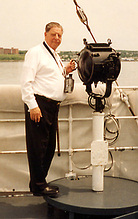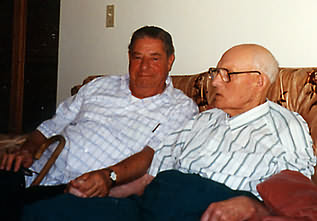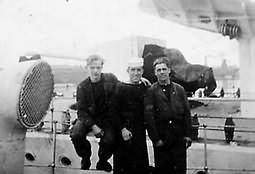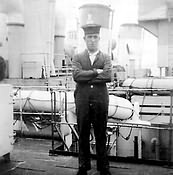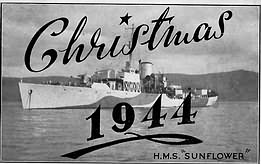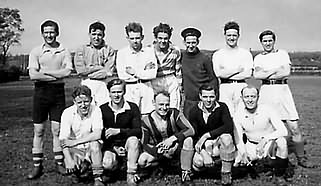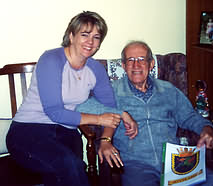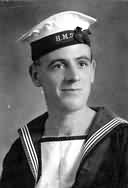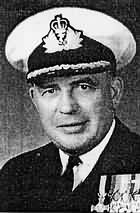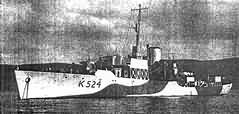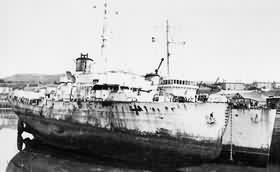|
Memories From the Sunflower
|
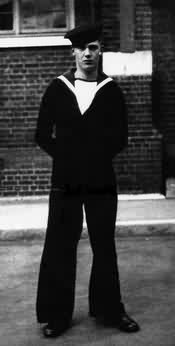 John Dixon
at Chatham
John Dixon
at Chatham |
That’s
me on the left John Dixon (Jack) to my friends I
was on HMS Sunflower the night HMS Firedrake was lost, and I will
never forget it.
We left Londonderry on the 12th December 1942 to join the west
bound convoy ON153 and 43 merchant ships bound for North America,
we were part of the escort group which consisted of fore Corvettes
and two Destroyers. The Sunflower which I was aboard built 1940.
The Alisma and Pink also built in 1940. And the Loosestrife built
in 1941. The two Destroyers were the Ripley a four funnelled American
Destroyer, its original name was the USS Shubrick built for service
in the first world war, and the Firedrake (H79).
It was on the evening of the 16th that the U-boat U211 attacked
the convoy. One report is that the U-boat Fired a spread of four
torpedoes into the convoy hoping to hit something in doing so
struck the Firedrake. Action stations had been sounded, my station
was the cordite supply to the 4" gun. I remember standing on the
gun platform with cordite container on my right shoulder, ready
to supply a reduced charge of cordite to the breach loader. The
mountainous seas were coming over the bows and drenching the gun
crew. It was freezing cold, a gale force wind was blowing, and
all I had on was my socks, underwear, sand-shoes and overalls
with a life belt around my chest. The order was given to load
star shell and shoot.
|
| After
two or three shells had been fired and had burst high in the night
sky, the stern section of Firedrake was sited at about midnight
stand down from action stations was sounded, I was told to get some
warm clothing on then with other ratings go down into the starboard
well deck to put the scrambling net over the ships side. This net
was there for the very reason that it was being used this very night.
There was another net situated on the port side, I could just make
out that some of the survivors were still on the stern section of
what remained of the Firedrake, others were hanging onto a floating
corked net approximately thirty yards off our starboard beam. |
|
It
was then one of our party, a Newfoundland rating by the name of
Furey, with a heaving line tied around his chest, lowered himself
down the scramble net into the sea. He then swam towards the floating
cork net. When he got there he entwined his arms in the netting
he became part of the "towing line". We then pulled the net towards
and finally along side the Sunflower. Able seaman Furey remained
in the sea to assist the men up the scrambling net on to our heaving
deck. As this brave action was taking place, the starboard bridge
communication signal lamp was being used to spot the other survivors
in the water. It was being used intermittently, because of the
fear of becoming another target for the submarine.
In
the beam of light a rubber dinghy was momentary illuminated, with
two men inboard. One of the men was stretched out, not moving,
the other man had a small paddle which he was using in his attempt
to make his way towards our ships side. The moment the light flashed
on him I saw and heard him call out for us to help those men who
were still in the water before rescuing them both. The two men
were probably duty stokers from the engine room, as they only
had vests and trouser overalls on. The hands of the man who was
paddling were blackened and appeared to have been badly burnt,
but he seamed to be void of experiencing pain.
|
We
managed to get 27 onboard but my friend Ted Adderly wasn’t one of
them, I was very much saddened; he was such a gentle young man.
One of the men we got aboard was an able seaman named W. Kay but
he was unconscious and covered in fuel oil. He was carried down
aft and put in the Petty Officers tiled wash room where I assisted
the sickbay rating to remove all his clothing .
We poured warm water over him to raise his temperature and at the
same time clean off the "stinking" oil. But sadly he died before
day break. Before we got to our final destination we lost two more
merchant ships the Otina on the 20th and the Oropos on the 21st.
|
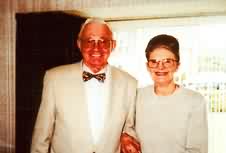 John and Renee Dixon Today
John and Renee Dixon Today |
| The
Wolf-pack "Raufbold" first sighted our convoy on the 15th December
and consisted of 13 U-boats namely the U135, U203, U211, U365, U409,
U410, U439, U600, U609, U610, U621, U623 and U664. They were responsible
for sinking 70 merchant ships. |
|
The
Hero of 17th December 1942
Leading Seaman George J. Furey
|
-1b.jpg) |
Leading
Seaman George
Joseph Furey
HMS Sunflower
Bill to some of his mates on board the Sunflower in 1942.
George was never issued a medal for his heroic action on the night
the Firedrake was lost with 168 young lives, even though he did
save the lives of 26 of the crew, but he was mentioned in dispatches.
The text of his recognition award is as follows:
" By the Kings order the name of Able Seaman George Joseph
Furey, HMS Sunflower, was published in the London Gazette on the
23 of March 1943 as mentioned in a dispatch for distinguished
service. I am charged to record his majesty's high appreciation"
signed by A.V. Alexander, First Lord of the Admiralty.
|
|
George's
sun Bill wrote to the association this year, this is his letter:
On the night the Firedrake was lost, my father went over the side
with a rope tied around his waist.
He would swim out to a man in the water and hold onto him while
his mates hauled him back onboard the Sunflower. He did this 28
times and saved 27 lives, the last man he brought to the rail
of the Sunflower slipped from his arms as he was too exhausted
to hold him any longer.
These were the only men saved from the Firedrake. My father was
a very strong man with lots of courage who took this extraordinary
action to save lives. Getting away from the side of a ship in
60 foot waves is quite a feat he did this 28 times.
One of the crew of the Sunflower a signalman, came to Newfoundland
from England a few years ago to visit my father he was still amazed
at the courage and strength of my father after 50 years.
|
|
George
died in April, 1996, at the age of 87. He lived a full life and
raised a family of ten children. While we knew that he had helped
save 26 men during the war, we didn't know all the details. He
was not one to talk about himself. Shortly before he died, I did
talk to him about it. He didn't see himself as a hero but talked
instead about the 27th man that he couldn't hold on to, due to
exhaustion. He was sorry that he couldn't have saved more.
|
|
George's
daughter Helen, also wrote to the association this is her letter:
Yes it is a truly amazing story. My father was a very humble man
from a small outpost community.
He never spoke much about the Firedrake disaster. Towards the
end of his life a gentleman from England wrote in a local paper
that he would be coming to Newfoundland and wanted to locate a
man "Fleury" who had saved the lives on the Firedrake.
Indeed he had got the name wrong but he was looking for my father
George Furey. My mom responded and the Evening Telegram, a local
paper ran an article on the reunion and the story of the rescue.
Many on board the Sunflower thought that my Dad had received a
medal but he never did, and if you knew my Dad , well he certainly
would not look for one. Newfoundland wasn't part of Canada at
the time and the Newfoundlanders enlisted as part of the British
Navy.
He reminisced at the end of his life that he should have rescued
more of the crew and felt badly that he had not reach more of
the young men in the water that cold night.
|
John
Masters Editor writes:
That any were saved at all was a miracle in its self, a howling
gale with force 12 winds and 60 foot waves crashing over the little
Corvette Sunflower, and what was left of the Firedrake, this was
a truly horrific scene with the chance of the Sunflower being torpedoed
at any minute. Why George was never given the VC or a medal for
bravery I will never understand. |
|
R.I.P.
A VERY BRAVE MAN
Leading Seaman George Joseph Furey,
MID
|
|
A
night I will never forget
by
Peter Collins
|
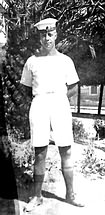 |
On
the night of 16-17th December 1942, I was an Ordinary Signalman
aboard HMS Sunflower, a corvette in the middle of Atlantic escorting
convoy ON153 to north America, in a force 12 storm, I night I will
never forget. This was the night that HMS Firedrake the escort leader
of the convoy was torpedoed and sunk by U-boat U211 with the loss
of 168 young lives. We on the Sunflower knew many onboard the Firedrake,
we used to go onboard her for games of Tomboler or bingo as it is
called today.
We the Sunflower had been on the other side of the convoy when Firedrake
had been hit so were not immediately aware of what had happened,
we were attracted by the site of star shells being fired about five
miles south of the convoy and when we tried to make radio contact
with the Firedrake who was convoy leader and couldn’t we went to
investigate, after sending up our own star shells and using binoculars
the captain could see what had happened. |
| So
we sped to the rescue, the Firedrake had been cut in two by the
explosion with the bow sinking within a few minutes, so we couldn’t
save anyone from that part of the ship, it had sunk before we got
there, we onboard the Sunflower were at action stations and ready
to take on the survivors that were still on what was left of the
Firedrake, but the weather was atrocious with sixty foot waves crashing
over our decks and force 12 winds, we couldn’t get close enough
to it to get the survivors off what was left of the Firedrake, which
was about two thirds of the ship, so the captain decided that it
would be safer to circle the ship until daylight hoping that the
weather may improve and then maybe setup a bosons chair and lift
the men off that way. |
| At
about a quarter to one in the morning on the 17th the Firedrake
sank, those onboard took to the sea, some were in a carly float
others were swimming in the freezing boiling sea, I shone my signal
lamp on the survivors in the water so that one of our seaman, George
Furey a Newfoundlander who had tied a life line around his waist
and gone overboard into the icy sea, could see where the men were,
so he could grab hold of them, when he had hold of one he would
be pulled back to the ship where the survivor would be helped aboard,
George managed to save twenty seven of the Firedrake’s crew this
way but one died before daylight, these twenty six were the only
survivors from the Firedrake on that terrible night I still see
in my minds eye that horrific scene of young men putting their arms
up, and slipping out of their life-belts so they would go under
quicker because they knew that they were too far from the Sunflower
to be rescued. |
| In
July 1995, I went to Newfoundland to visit George Furey, the meeting
was covered by the local news paper the ‘Evening Telegram’, the
story got the front and inside page’s with photos and told of George’s
heroism, George always wished he could have saved more and would
have done if it hadn't been for the weather and extreme cold. |
|
|
The
photo on the left is Peter Collins standing at the signal lamp on
the corvette that is preserved in Canada.
The photo on the right shows Peter Collins and George Furey at the
meeting in Newfoundland in July 1995, together again after 52 years |
|
 |
Stan Clark Remembers
|
|
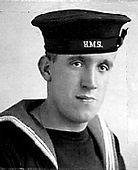 |
Stan
Clark was part of the gun crew on the Sunflower on the night the
Firedrake was lost, he will never forget that night.
There was a raging storm, we were tossing about like cork in a whirl
pool, it was in the evening of the 16th December 1942, when our
radio operator had reported to our captain that he couldn't contact
the Firedrake, we could see star shells exploding in the sky about
five or so miles south of the convoy but couldn't leave our station
which was on the west of the convoy of forty three ships on their
way to Canada, after several hours of our sparks trying to contact
the Firedrake the captain decided to see what was was happening
south of the convoy, so we were called to action stations and steamed
at full speed to where the action was, as we got closer the captain
thought he could see a U-boat on the surface. |
So
we were ordered to load with "HE" high explosive, then
waited for the order to fire, as we got closer he could see that
it was not a U-boat but in fact the remains of the Firedrake which
had been cut in two, only the stern was still afloat, we were ordered
to unload "HE" and reload with Star Shell and fire above
the wreck, the first round we fired failed to spark up, so we fired
another which did light up then we all could see the smashed wreck
of which was the Firedrake.
There was men in the water but the whether was so bad with mountainous
waves crashing down on us that we couldn't get to them, we could
see there was men working on the wreck and she looked as if she
would stay afloat, so our captain decided to circle the wreck till
day light hoping that the storm might subside, we had scramble nets
over our sides still trying to rescue those in the water, but we
felt so helpless.
Then just after midnight we could see that she was going down, and
the men on board were taking to the water, one of our crew a chap
from Newfoundland tied a rope around his waist, with two others
holding the other end he also went into the water, he swam out to
the nearest man grabbed hold of him while the two on the other end
of the rope pulled him back to the ship, they managed to get twenty
seven on board the rest were lost it was a terrible shame but we
did the best we could, in the night one of those they had got aboard
passed away so the total saved was twenty six. |
| Below
some of the many photos that Stan has, and looks at from time to
time, Left: Stan with two of his mates on the Sunflower in 1943,
in the Centre wearing an American hat. Middle: Stan wearing his
own hat. Right: A Christmas card he sent home in 1944. Bottom Left:
The Sunflower football team. Bottom Right Stan and Angela, his niece
today in September 2003. |
 |
More from the Sunflower
|
|
|
|
Photo
left: Reg Barton
Was also on the Sunflower and remembers vividly the night Firedrake
sank, he also helped get men out of the water, He as very kindly
sent some more photos of the Sunflower and her crew and some very
interesting bits of information.
Photo right: Cpt Treasure Jones
Was the skipper of the Sunflower on the night of Firedrake's sinking.
He also skippered the Mauretania and the Queen Mary. |
|
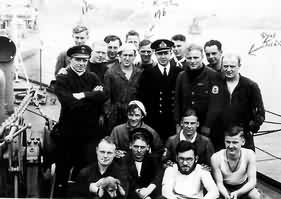 |
Photo
Left: This Photo was taken aboard The Sunflower, there are three
arrows pointing at various people from left to right, Phil
Reg's mate the next arrow is Reg himself and then
the third arrow is pointing at Syd Jarman. The rating
with the beard second from the right at the front sitting down is
Peter Hammond who later became an Anglican Priest
and is pictured on the right with one of his sons in 1958. |
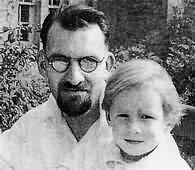 |
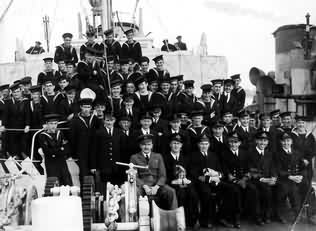 |
Photo
left taken aboard the Sunflower, Reg is behind the
officer with the cat. The sailor on the extreme right is Fred Garner
who was transferred to the Firedrake as a leading stoker so was
lost when the Firedrake was sunk.
Photo Right: Cpt Thomas Fanshawe he was the first
lieutenant on the Sunflower, he had served on the Royal Oak, Iron
Duke, The Jervis Bay the River class frigate Rother, his first command
was the flower class corvette Clover. |
|
|
Three
different Pictures of the Sunflower
|
| This
taken 1941. From the Imperial War Museum Archives. |
|
This
taken at Belfast after a refit 1944, note the pennant No. was changed
from K41 to K524. |
|
This
taken at Hayle Cornwall waiting for the breakers torch 1947. |
|


-1b.jpg)


